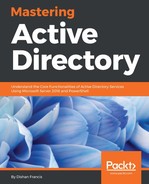An Active Directory domain controller supports holding nearly 2 billion objects. As the number of objects increases in the infrastructure, the effort we need to put in, in order to manage it also increases. If we have a proper structure to group these objects into small groups, then we have more control over it and we know at a glance where we can find the specific object:

In the preceding example, Rebeladmin Corp. has nearly 100 salespersons. They are also using nearly 150 desktops and laptops. There is no problem putting all these objects into the root of the hierarchy (under default containers). But it will not be easy to identify Sales department objects from other Active Directory objects. Instead of that, we can create the OU for Sales department. It can be further categorized into two OUs: Users and Computers. Both of these OUs are in the same hierarchical level. Now if we need to locate a user object in Sales department in Active Directory, we definitely know it should be under the Users OU of the Sales department OU. In the same way, if we need to add a new Active Directory object under Sales department now, we have a predefined structure in which we place it. Every engineer in the IT department should follow the same structure when managing objects, and it will not change based on the individual's preferences.
